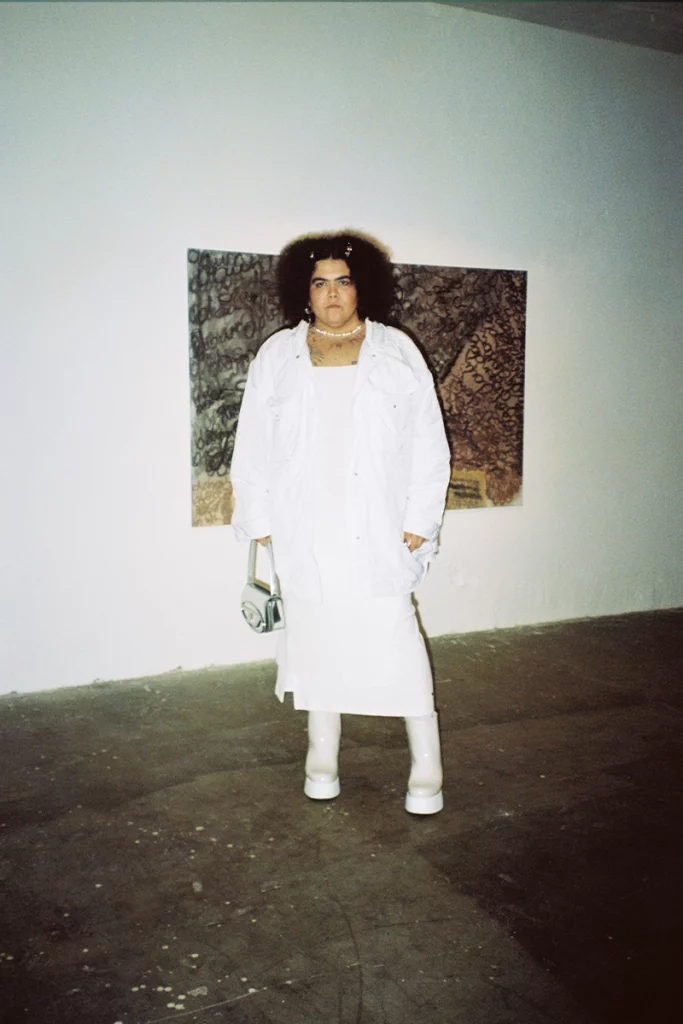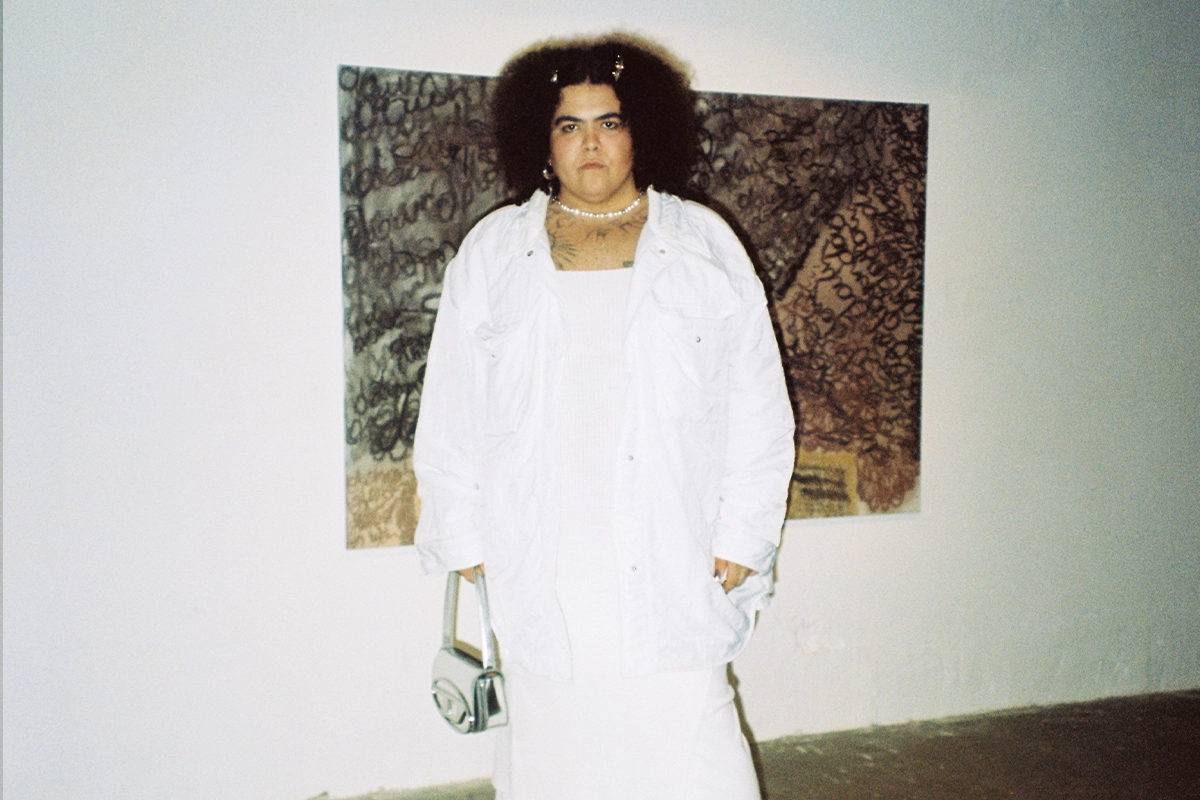Queer artist Jota Mombaça discusses her work as a radical reorientation to history and memory, allowing the elements to reveal perspectives inaccessible to people
Performances and biography – the queer interdisciplinary artist Jota Mombaça
Jota Mombaça’s art approach is to work with natural materials as a means to approach questions of a post-colonial ethical society. Heady in concept, her works are reliant on a logic of art making that is sensual and embodied. Mombaça often asks what materials and elements can observe, expanding a limited western conception of cosmology. Through this, ethical storytelling becomes a transformative act, bringing us into a system with natural processes, spirits, and the unknowable.
In one of most arresting works, Jota Mombaça considers the destroyed archives of Brazil and Columbia. Illuminating her entire practice, she uses performance as a way of considering different modes of being. She asks, Has the fire read the stories it burns? and quite literally reads archival material as it is being consumed by fire. In this way, she offers an alternative. The discontinuities this reading creates reflects a history of fractures and ghosts. It also asserts an alternative approach to history, where time is not linear and material is transformed, not destroyed. In this conversation with Lampoon, Mombaça discusses the robust ways her work is able to engage in transformation and transition. Because for her, transition is utopia.
A European migrant rather than a Brazilian citizen – Jota Mombaça
Recently, I’ve been practicing as an interdisciplinary artist; I don’t commit to a unique medium. I come from Brazil but I migrated to Europe a few years ago. I sometimes see myself more as a migrant than as a Brazilian but am still definitely connected to Brazil. I’m also a writer. My practice used to feature writing more centrally, but at a certain point I decided to stop taking writing commissions to start to focus on my material practice.
Jota Mombaça on performance art as a mediator for all other mediums
I have a background in performance that mediates my work in all other mediums. For instance, I did a series of drawings in the dark, connecting more with the sound the charcoal made than its visual imprint. I have a performative way of drawing. Recently, I have enacted a number of sinkings, where I was trying to think with water. I will sink materials and leave them beneath different bodies of water for an extended period of time. There is also a performative level to those sculptures. Even in my video and sound works, I’m often somehow reaching things through a performance art mindset. There’s something of a performance art method that informs my practice and my relationship with almost every medium.
Grounding and Ungrounding in installation work – Jota Mombaça
I try to play with grounding and ungrounding. I’ve been thinking about my recent works as entities that have the power to haunt, to keep appearing and disappearing. In exhibitions and installations, often something can reach you, through an atmosphere, before you apprehend and interpret it. They operate through sensitivity rather than intellectualism or rationality. That is what I am aiming for when I incorporate these materials that spend time under the water in my exhibitions, so that they haunt us with their experiences. I am interested in the material’s perspective, what they can witness or experience; I can’t spend seven weeks under the Pacific Ocean! I think a lot about grounding in an ungrounded kind of way.

Balancing a research-based practice with aesthetic concerns: the tension between ephemerality and criticality
Aesthetics always exist for me as a provisional element. I always aim for a fluid sculpture that does not sit in a single form. With my sunk work, materials resurface and are incorporated into an installation for instance in which they will formally respond to the architecture, the locality and the specificity of a space. The aesthetic elements of the work usually respond to the particular environment where the work is shown. That’s one point.
I’m also quite interested in another aspect of aesthetics. I like to ask what the aesthetic of the Pacific Ocean, San Francisco Bay, the Venice Canal, or Rio de Janeiro is? What are the aesthetic points of view? How can they produce a certain aesthetic that we can think with, just as we look at and think with the aesthetic that I propose? When you look closely at my sunk textiles, you see stained sediments and broken parts. Sometimes I read some of the text as abstract, elemental abstractions. Just as you can look at an abstract European painting, consider its light, and other elements, elemental imprints also carry the possibility of us reading something.
A lot of my work considers reading and affecting through the elements themselves. Despite the prominence of aesthetics, I also believe there is an aesthetic relationality. I don’t want to be at the center of the aesthetic decisions, but to be in relation with the environments, with the spaces, and with the elements that come into play on each project.
Jota Mombaça on her role as a conduit
I see myself as someone who can practice the gesture of being possessed by the elements. I have an agency which belongs to my personhood, to the person I am, to the questions I bring. That’s why I relate with these elements and think about questions of migration, race, and gender. I also need to see myself as someone who can let go of themself, in order to connect with and learn from different agencies. I don’t like the idea of the artist as a genius. I cannot control the outcome of 20 meters of linen I have sunk in the Pacific Ocean for seven weeks.
Jota Mombaça on relinquishing control to the elements
I was doing a project in San Francisco last year and had sunk a textile for four weeks. That was my agency, my decision, my imposed timeline. At the end of the fourth week, the tide was too high for us to access my piece, and we had to wait for three more weeks. My agency, and that of my exhibiting institution, was disturbed by the agency of the tide. It would be incredibly egoistic to be upset by this. Instead, I would like to respond to these forces. I find an aesthetic response by accepting the agency of the elements. I try to be flexible and open so I can relate with the elements that compose my work.
On working with a burning archive – Has the fire read the stories it burns
In 2018 and 2019, I was already approaching the elements. I thought a lot with fire, it was a present question for me. I kept asking, has the fire read the stories it burns. If the fire can be read, the burning might mean something else. For non-western, non-colonial cosmologies, burning can mean something other than erasure. In asking these questions, I returned to the question of the Brazilian archive. We have had several burnings in the Brazil context. Notably, the finance minister set everything on fire after the formal abolition of slavery. These moments of amnesia constitute Brazilian historical memory. My questions of fire became immediately political.
The manifestation of the original fire questions – Jota Mombaça
I was invited to Columbia in 2019 to perform something at a National Arts event. My performance was simple, I read pages of archival material I had collected during my research in Columbia. The history of violence in Columbia is particular to its context, but in Brazil, Bolsonaro had just been elected, and I felt a resonance across both countries. My performance consisted of the reading of this archive while it was burning and my attempt generated a scattered reading in which I would start something and then have to jump immediately. The text was composed throughout the performance. The Columbian archive is difficult to navigate, you find ghosts. There is an encounter which calls for a form of reading that is discontinuous. I think I tried to embody that somehow through this particular project.
Jota Mombaça on her relationship to museums, galleries and performance art
I’m strategic in how I relate to galleries and museums, these banks of cultural value. These spaces define value and write history. For my generation, especially racialized and queer artists, there was this desire to affect change from within. Instead, I am considering what can be done with these possibilities. I try to play with it as much as possible because that’s also how these spaces operate in relation to my body and other racialized, trans, queer artists. There is a need to place yourself in certain boxes and make work considering certain dynamics. There are words every racialized trans artist needs to use when working in the institution of art. One is the world you want to do, and the other either confirms or disrupts the versions of yourself that the system generates. We somehow need to relate to readings of ourselves that the system generates.
Jota Mombaça on contextualized meaning
When you think about the white history of art, you find many moments in which people are thinking about color, geometric form, light. Then, when you look into Black and indigenous histories of art, contemporary art especially, you find that first, for us to think about light, we need to think about how light is perceived from a certain position in society. Society produces segmented places for our experiences to unfold. This can be heady at times, but also can be generative.It offers a different mode of engagement. How do we stay in relation to those institutions without being eaten by them? I don’t know. I’m thinking about this a lot now because it changes often.
Time is spiraling. The conception of time according to Jota Mombaça
I’m interested in time and the concept of grieving time. The time my sunk materials spend under the water is transitioning towards a different time. When I was doing this project in the US, I had a visa issue which disrupted my sense of time. I began to think about how migration relates with time. Modernity produces linear time and most of the violences of modernity somehow consists of stealing time. The production of time as a linear thing is already a gesture of theft; of the experience that we could have instead. I also think about the idea of spiral time which entails a different relationship to time than that of the linear arrow. We have a form of imprisonment through linear time which is violent. Western, white social order cannot exist without it. My work tries to mourn this and to grieve this time and also reach other temporalities and other ways of addressing time.
According to Jota Mombaça utopia is transition
I’m a bit resistant to utopias because I’m more interested in transitioning towards them. Often when we think about utopias, we formulate an image that always requires the movement of transition, which tends to be messy and complicated. Speaking from my own experience, that is how transition is experienced. My personal utopia is to engage continuously with transition towards something that might one day make sense. Engaging with, and learning from transition is my utopia. I’m trying to nurture a collective, planetary scale transition and bravely strive for it.
Jota Mombaca biography
Artist Jota Mombaça is an interdisciplinary artist whose work unfolds from poetry, critical theory, queer studies, political intersectionality, anti-colonial justice, and the redistribution of violence. Mombaça defines themselves as a non-binary black bicha (slang term used against gay men) born and raised in Natal, in the northeast of Brazil.



















